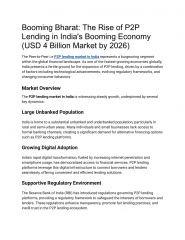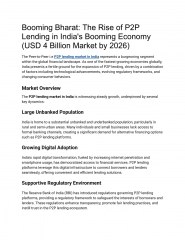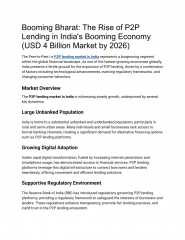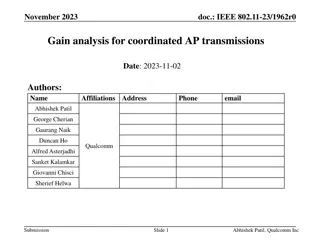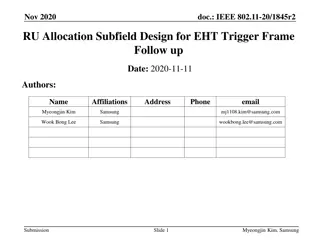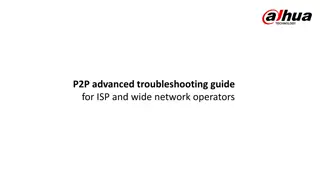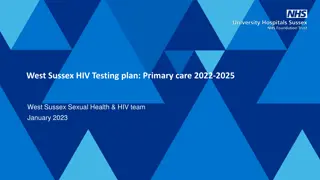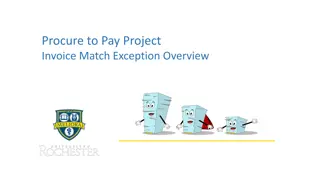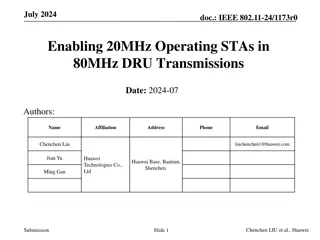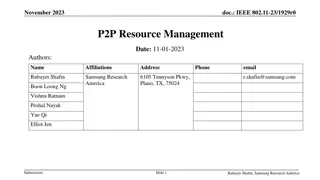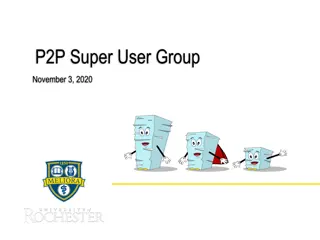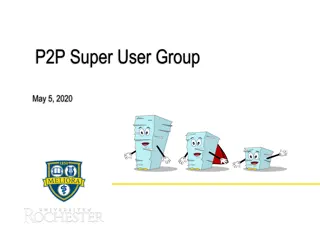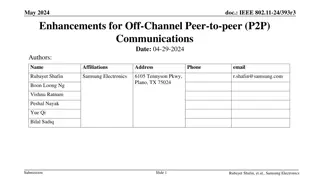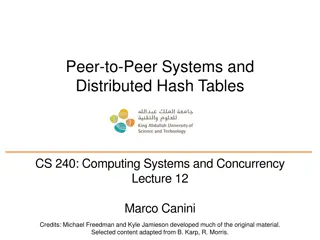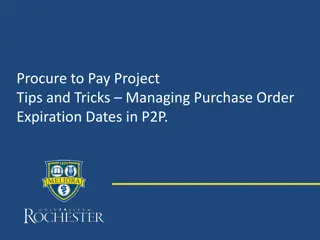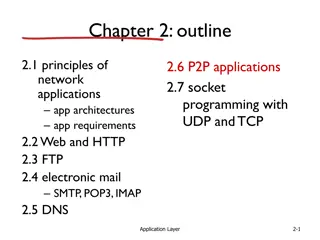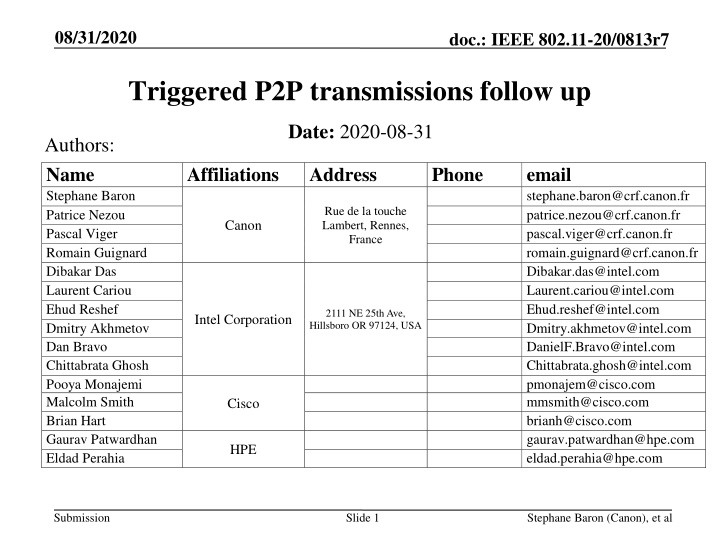
Efficient Triggered P2P Transmissions for IEEE 802.11-20 Network
Explore the benefits of Triggered P2P transmissions in IEEE 802.11-20 networks, enhancing communication efficiency for high-throughput applications like Miracast streaming and VR. Learn about Direct Link Scheduled communications and how a trigger-based DiL sequence optimizes medium management, improving QoS within BSS. Addressing inefficiencies of legacy STA, this approach aims to enhance AP awareness of resource requests, reducing medium inefficiency.
Download Presentation

Please find below an Image/Link to download the presentation.
The content on the website is provided AS IS for your information and personal use only. It may not be sold, licensed, or shared on other websites without obtaining consent from the author. If you encounter any issues during the download, it is possible that the publisher has removed the file from their server.
You are allowed to download the files provided on this website for personal or commercial use, subject to the condition that they are used lawfully. All files are the property of their respective owners.
The content on the website is provided AS IS for your information and personal use only. It may not be sold, licensed, or shared on other websites without obtaining consent from the author.
E N D
Presentation Transcript
08/31/2020 doc.: IEEE 802.11-20/0813r7 Triggered P2P transmissions follow up Date: 2020-08-31 Authors: Name Stephane Baron Patrice Nezou Pascal Viger Romain Guignard Dibakar Das Laurent Cariou Ehud Reshef Dmitry Akhmetov Dan Bravo Chittabrata Ghosh Pooya Monajemi Malcolm Smith Brian Hart Gaurav Patwardhan Eldad Perahia Affiliations Address Phone email stephane.baron@crf.canon.fr patrice.nezou@crf.canon.fr pascal.viger@crf.canon.fr romain.guignard@crf.canon.fr Dibakar.das@intel.com Laurent.cariou@intel.com Ehud.reshef@intel.com Dmitry.akhmetov@intel.com DanielF.Bravo@intel.com Chittabrata.ghosh@intel.com pmonajem@cisco.com mmsmith@cisco.com brianh@cisco.com gaurav.patwardhan@hpe.com eldad.perahia@hpe.com Rue de la touche Lambert, Rennes, France Canon 2111 NE 25th Ave, Hillsboro OR 97124, USA Intel Corporation Cisco HPE Submission Slide 1 Stephane Baron (Canon), et al
08/31/2020 doc.: IEEE 802.11-20/0813r7 Authors: Name Sharan Naribole Srinivas Kandala Mohamed Abouelseoud Thomas Handte Taewon Song Sang Gook Kim Affiliations Samsung Samsung Sony Sony LG Electronics LG Electronics Address Phone email n.sharan@samsung.com srini.k1@samsung.com Mohamed.Abouelseoud@sony.com Thomas.Handte@sony.com taewon.song@lge.com sanggook.kim@lge.com Submission Slide 2 Stephane Baron (Canon), et al
Dibakar Das etal, Intel August 2020 doc.: IEEE 802.11-20/0813r7 Abstract Propose a simple/low-complexity Triggered P2P scheme to be used for 11be R1. Submission Slide 3 Stephane Baron, (Canon), et al
Dibakar Das etal, Intel August 2020 doc.: IEEE 802.11-20/0813r7 Introduction Direct Link transmission => A Direct Link Scheduled ( DLS ) STA communicates directly with another Direct Link Peer STA ( DLP ). Benefits of Direct Link ( DiL ) transmission [1] : high throughput because lower number of transmissions low latency due to one hop communication. Use-case of interest: Miracast streaming from laptop to monitor. VR applications Wireless file transfer from phone to printer. TXOP AP DiL-A SIFS Data DLS STA DLP STA SIFS Ack Submission Slide 4 Slide 4 Stephane Baron, (Canon), et al
Dibakar Das etal, Intel August 2020 doc.: IEEE 802.11-20/0813r7 Trigger based DiL sequence benefits A DiL transmission sequence initiated by a TF transmission has following benefits for both the peer STA and AP . Increases the chances of P2P transmission as AP typically has higher chance of winning contention. Better medium management at AP as it can balance QoS requirements (e.g., low peak latency) within BSS by scheduling P2P STA and regular STA in same TXOP. Submission 1117r1 (appendix) mentions some inefficiency of QTP to support Direct link: Legacy STA not prevented from channel access. AP is not aware of actual resource requests at STA during the QTP period. The initial configuration of schedules may be stale => medium inefficiency. Submission Slide 5 Stephane Baron, (Canon), et al
Dibakar Das etal, Intel August 2020 doc.: IEEE 802.11-20/0813r7 Possible Topologies Case 1 Case 2 AP in the ceiling of an office AP in the ceiling of an office DLS STA (laptop) DLP STA (wireless monitor) DLS STA (laptop) DLP STA (wireless monitor) Both STAs associated to same AP. [Optional] Another AP in the ESS Only one STA associated to the Triggering AP. : AP : Non-AP STA Submission Slide 6 Stephane Baron, (Canon), et al
August 2020 doc.: IEEE 802.11-20/0813r7 Principle P2P traffic is triggered by the AP for a Single-User style PPDU : AP can share a part of the TXOP to the P2P traffic. P2P traffic uses a P2P RU = n x 20MHZ covering all the operating band for that period of time. The TF format can be similar to 11ax/11be Basic TF format except small changes to clarify the allocation is for P2P traffic. Peer STA may not be allowed to use EDCA after being triggered for some time (e.g., by extending MU-EDCA rules) TXOP owned by the AP TF for P2P AP Allocated time STA1 P2P PPDU SU PPDU (N x 20MHz) STA2 ACK 2 1 SIFS SIFS Submission Stephane Baron, (Canon), et al
August 2020 doc.: IEEE 802.11-20/0813r7 Example in cascading sequence TXOP MU cascading sequence HE MU PPDU /TRS or TF TF for P2P Multi STA Block Ack AP Allocated time P2P PPDU STA1 STA2 ACK 2 1 UL Length SU PPDU (N x 20MHz) HE TB PPDU STA3 HE TB PPDU STA4 SIFS SIFS SIFS SIFS SIFS Submission Slide 8 Stephane Baron, (Canon), et al
Dibakar Das etal, Intel August 2020 doc.: IEEE 802.11-20/0813r7 Summary Discussed challenges with Triggered P2P operation. Proposed a simple solution for R1 Submission Slide 9 Stephane Baron, (Canon), et al
doc.: IEEE 802.11-20/0813r7 Straw Poll #1 Do you support that 11be defines in R1, a procedure for an AP to share a part of the obtained TXOP for peer-to-peer (non-AP STA to non-AP STA) frame exchanges by signaling in a trigger frame, a TBD field specifying the allocated time for the peer to peer communication, and only one RU allocated to one non-AP STA associated to that AP. Note : Format of trigger frame is TBD. Informing the AP of P2P traffic required resource, may be based on any existing mechanism (e.g. BSR on per packet level, TSPEC at stream level, or any TBD channel access/TWT/scheduling mechanism.) Peer STA may not be allowed to use EDCA for some time for P2P transmissions after being triggered (e.g., by extending MU-EDCA rules). Results: Y/N/A Submission Slide 10 Stephane Baron, (Canon), et al
August 2020 doc.: IEEE 802.11-20/0813r7 Reference [1]. 11-18-1481-01: Technology for EHT [2] 11-20-0871-00-be-simplified-p2p-release1 [3]. 11-19-1117-00: Coordinated OFDMA Operation [4]. 11-20-0095-02: Triggered P2P transmissions [5]- 11-18-2009-06-0rta-rta-report-draft Submission Slide 11 Stephane Baron, (Canon), et al
Dibakar Das etal, Intel August 2020 doc.: IEEE 802.11-20/0813r7 Backup slides Submission Slide 12 Stephane Baron, (Canon), et al
August 2020 doc.: IEEE 802.11-20/0813r7 FAQ C: Is this a new P2P protocol like TDLS, WFA protocols etc. ? R: No. The proposed mechanism only deals with AP granting explicit channel access to a peer STA using a Ctrl frame and hence is orthogonal to the P2P protocol (P2P discovery, session/schedule setup, security establishment etc.). The proposed scheme therefore complements existing P2P schemes. C: How many and what type of frames can peer STA transmit during allocation ? R: Any frame the peer STA is allowed to transmit to the other peer. C: Why not use RDG ? R: Using RDG to assist P2P requires implementations to build RDG support followed by any P2P extensions. This is more effort implementation-wise and equivalent effort spec-wise. C: Is the peer STA assumed to be soft-AP ? R: It can be soft-AP or just a non-AP STA. We intend to not bring up any soft-AP definition but rather just use the term currently used in spec for QTP : peer-to-peer link . C: What is the performance gain ? R: It is scenario dependent in the same way as TF versus EDCA for UL transmissions. If the network is not busy, the gains may not be high. If the network is busy, this is useful esp. for QoS Mgt as it can reduce contention among non-AP STAs. Submission Slide 13 Stephane Baron, Canon, et al
August 2020 doc.: IEEE 802.11-20/0813r7 FAQ (contd.) C: What else would you require ? R: All that we need is captured in the notes: Capability signaling during association. Signaling presence of P2P traffic (using a new TID value between 8-15 in QoS Null frame) or using existing schemes such as TSPEC or similar. MU-EDCA type mechanism following triggered P2P to restrict EDCA by non-AP STA. C: How do you know the peer STA is going to use the allocation ? R: Peer STA can signal presence of P2P traffic (see Notes). AP can recover TXOP using baseline mechanism if peer STA does not transmit. C: Are we defining new terms for peer STA pairs ? R: No. The terms DLP and DLS used in this presentation are just for illustration purposes. In the spec, we can use any traditional terms for them (e.g., STA that supports Triggered P2P ). C: Why not restrict to TDLS use-cases ? R: We don t see any technical/spec reason to restrict the scope to TDLS. Note that the protocol only depends on one peer STA being associated to AP. Since the other STA need not be known at AP, there is no need to restrict. Submission Slide 14 Stephane Baron, Canon, et al
August 2020 doc.: IEEE 802.11-20/0813r7 Triggered P2P Transmissions follow up No Change in the direct link setup/teardown procedure. Triggered P2P feature should be controlled by a capability (both at AP or STA level). A non-AP STA can signal the need for P2P transmission thanks to Tspec or BSR (exact signaling is TBD). P2P traffic is triggered by the AP for a Single-User style PPDU : AP can share a part of the TXOP to the P2P traffic The AP provides resource to the source P2P station that is associated with it. TF May be included in a cascading mechanism. P2P traffic uses a P2P RU = n x 20MHZ covering all the operating band for that period of time. Simple signaling (typically 1 bit) to signal P2P RU . P2P traffic uses its own preamble on its distinct channel : AP does not need to provide all trigger transmission parameters (e.g. MCS) No synchronization requirement (even for Ack part) PPDU format is TBD (e.g. SU or MU PPDU format can be envisaged) Submission Slide 15 Stephane Baron, (Canon), et al
August 2020 doc.: IEEE 802.11-20/0813r7 1117r1: Direct Link issues with 11ax amendments Direct link provides high interferences to the AP Direct link traffic carries large amount of data Large video transmission for VR, or video streaming. Direct link traffic often requires low latency thus frequently accesses the medium. Interactive applications (VR, visio conferences, etc.) Direct link cannot be efficiently scheduled by an AP today AP cannot trigger the sending of direct link data, so fine scheduling is not possible. Direct link only relies on EDCA. Multi User OFDMA doesn t support Direct link traffic. Quiet time period mechanism is not incentive enough Every station with direct link traffic will contend on the same period. Even if this period has been negotiated by a STA, the quiet time period is open for all direct link stations Other stations with uplink data may also contend during this period (Quiet time period is just intended to give a better priority of medium access for direct link traffic). No specific protection against legacy stations. Submission Slide 16 Stephane Baron, (Canon), et al
Dibakar Das etal, Intel August 2020 doc.: IEEE 802.11-20/0813r7 Motivation P2P communication can significantly reduce the load on the BSS and simultaneously the latency by a one- hop communication. About 70% reduction in latency/airtime possible in the two floor home scenario by using P2P communication among users in the same room. Submission Slide 17 Stephane Baron, (Canon), et al
August 2020 doc.: IEEE 802.11-20/0813r7 Example in cascading sequence 2/2 TXOP MU cascading sequence HE MU PPDU / TRS or TF HE MU PPDU /TRS or TF Multi STA Block Ack AP Allocated Time P2P PPDU STA1 STA2 ACK 2 1 UL Length SU PPDU (N x 20MHz) HE TB PPDU STA3 HE TB PPDU STA4 SIFS SIFS SIFS SIFS SIFS Submission Slide 18 Stephane Baron, (Canon), et al

